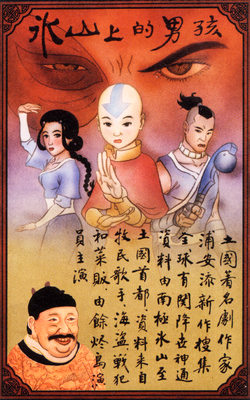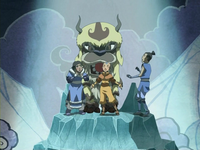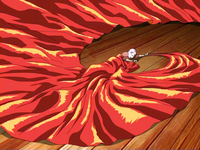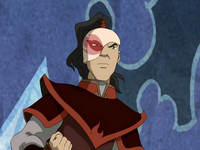- This article is about the play. For the first episode of Book One: Water with the same name, see "The Boy in the Iceberg".
| "The Boy in the Iceberg is a new production from acclaimed playwright Pu-on Tim, who scoured the globe gathering information on the Avatar from the icy South Pole to the heart of Ba Sing Se. His sources include singing nomads, pirates, prisoners of war, and a surprisingly knowledgeable merchant of cabbage." |
| — Sokka reading the promotional poster to Team Avatar.[1] |

The poster for The Boy in the Iceberg features caricatures of Aang, Sokka, Katara, Zuko, and its writer, Pu-on Tim.
The Boy in the Iceberg is a play created by acclaimed writer Pu-on Tim and performed by the Ember Island Players. Carefully researched, the play follows Team Avatar's journey in helping Avatar Aang master all four elements. Pu-on Tim's sources include singing nomads, pirates, prisoners of war, and a cabbage merchant.
The play begins with Katara and Sokka finding Aang in the iceberg. It progresses to Team Avatar's escapades in the rural Earth Kingdom, Northern Water Tribe, Ba Sing Se, and the assault on the Fire Nation Capital. The play also exhibits Fire Nation propaganda and ends with the defeat of Aang and Zuko, resulting in the subsequent victory of Ozai and the Fire Nation.[1]
Origins
Awake for days at a time during pre-production, Pu-on Tim, who often described the experience of following the Avatar as a "painful and blurry dream", was almost driven to insanity while writing The Boy in the Iceberg. It was as if he had managed to talk to every person with whom Aang had come into contact, likely over the weeks Tim spent on the road researching leads and tirelessly following Aang. These seven months[2] of information-gathering ultimately accumulated hundreds of scrolls filled with notes about the Avatar.[3]
Play
There are three acts separated by two intermissions.
Act I

Katara and Sokka's discovery of Aang is the play's first key scene.
- Katara and Sokka release Aang from the iceberg and discover he is the Avatar.
- Zuko and Iroh search for the Avatar.
- Aang finds Momo at an air temple.
- Sokka asks Suki, the Kyoshi Warrior, if his Kyoshi Warrior dress makes his butt look too big.
- Aang must answer Bumi's riddles if Team Avatar is to leave Omashu.
- Katara steals the waterbending scroll from pirates.
- Zuko captures Aang, but the mysterious Blue Spirit saves the Avatar.
- Jet wipes out the "nasty town" for Katara.
- A disinterested Team Avatar flies over the Great Divide.
- Sokka says goodbye to Yue as she departs to become the moon.
- The Avatar transforms into Koizilla and defeats the Fire Nation armada.
Act II
- The Avatar finds an earthbending teacher, Toph, a muscular blind man who sees by releasing a "sonic wave" from his mouth.
- Zuko and Iroh split up after an argument over Zuko's hair.
- Team Avatar, Zuko, and Iroh confront Azula, but she escapes by distracting Zuko.
- The drill tries to penetrate the walls of Ba Sing Se.
- Jet is hypnotized by Long Feng and attacks Team Avatar, but he is killed by a falling rock.
- Katara admits her romantic feelings for Zuko while imprisoned with him in the Crystal Catacombs.
- Azula challenges Zuko to choose his country or treachery. Zuko chooses his country and pushes Iroh down, yelling that the latter smells and that he hates him for all time.
- Mai and Ty Lee defeat a pair of royal guards. Aang enters the Avatar State, but is shot down by Azula's lightning.
Act III

Aang is killed by Ozai, securing total victory for the Fire Nation.
- Team Avatar infiltrates the Fire Nation.
- Katara becomes the Painted Lady.
- Sokka acquires a sword.
- Combustion Man dies.
- The Fire Nation is invaded.
- Zuko joins Team Avatar.
- The Fire Lord plans to use the power from the Comet to fight the Avatar.
- Azula and Zuko battle; Zuko loses.
- Ozai and Aang battle; Ozai defeats Aang.
- Ozai achieves total victory and the Fire Nation conquers the world.
Characters
(All of whom are portrayed by actors)
- Katara
- Sokka
- Aang
- Appa
- Zuko
- Uncle
- Momo
- Bumi
- Jet
- Suki (non-speaking)
- The Blue Spirit
- Yue
- Toph
- Azula
- Ty Lee (non-speaking)
- Mai (non-speaking)
- Ozai
- Combustion Man (mentioned only)
- The Painted Lady (mentioned only)
Differences between characters

Zuko's scar is on the wrong side of his face.
- Katara is a well-endowed woman who is overly melodramatic. She is constantly preaching about hope.
- Sokka is portrayed as overly fixated on food. However, after Sokka himself gives advice to his actor, the portrayal becomes more similar to Sokka's true comedic nature.
- Aang is played by a female and portrayed as a goofy prankster.
- Zuko's zealous search for the Avatar to restore his honor is referenced as a joke in the play. In the play scene referencing "The Chase", Azula distracts Zuko and Team Avatar by claiming to see Zuko's honor. When Zuko is defeated in Act III of the play, he screams "honor!"
- In the play, Zuko's scar is on the right side of his face instead of the left. A little boy dressed like Aang said to the real Zuko that "the scar is on the wrong side."
- Uncle Iroh is portrayed as a useless glutton who is fixated on cake instead of tea. He also seems to be less spiritual.
- Toph is portrayed by a buff man who claims that he is blind but can visualize his surroundings by releasing a sonic wave from his mouth.
- In the scene referencing the "The Blue Spirit", the Blue Spirit saves Aang from Zuko even though The Blue Spirit is Zuko's alter ego. His mask is also overly large and silly. Commander Zhao, who really captured Aang, was absent from the scene and was replaced by Zuko.
- While Azula is portrayed as demonic and evil, she is neither calculating nor excessively cruel. Her speech is strangely bombastic and she is seen wearing pink clothing with periwinkle blue eye-shadow.
- Ozai is portrayed as a stereotypical villain, displaying over-exaggerated facial features and able to disappear in a puff of smoke. Much like Azula, his manner of speaking is quite bombastic.
- Mai's actor covers her eyes with her bangs and holds her stilettos (short daggers in the play) in her hair instead of her robes.
- Ty Lee's fighting style is overly simplified and more comical than the real Ty Lee's. She is depicted as an overweight ballerina.
- Jet's plan to wipe out Gaipan, which Katara was horrified by and was foiled by Sokka, is portrayed as successful and done to please Katara. Additionally, as opposed to being a calculating freedom fighter driven by revenge, Jet is later depicted as mentally unstable, with his trademark sprig of wheat replaced by a flower, who ends up crushed by a boulder, rather than fatally wounded by Long Feng.
- Momo is a small hand puppet who can talk. Aang's actor voices one line for the puppet: "Hi, everybody. I love you!"
Reception
Critics were negative toward the production, calling it merely "watchable". During its short time in the theater, however, this play truly made an impression. Some of the audience members liked it so much that they even dressed up like their favorite characters. It was not uncommon to see several "Prince Zukos" excitedly watching the play. Team Avatar was aghast at how unfaithfully they were portrayed, particularly Aang, who was shocked at the fact that a woman was playing him, and Zuko, who felt that the play portrayed him as "totally stiff and humorless". At the end of the production, they declared it to be horrible, though Sokka commented that the effects were decent.
Despite less-than-favorable reviews, Pu-on Tim could not have been happier with his unbiased view of the Avatar and his companions, even venturing to call The Boy in the Iceberg his "masterpiece".[3]
Special effects
- In battle scenes, the actors used rolled streams of confetti to represent bending and lightning.
- During a scene in "Jet", several stagehands carried a blue roll of paper to symbolize the town being flooded.
- During a battle scene with Mai, a stagehand took the blade out of her hand and ran with it across the stage, making it appear as if she had thrown it.
- In the scene of "The Drill", stage workers use fans to blow dust across the stage to create the effect of the Outer Wall turning to sand as the drill makes its way through.
- In order to replicate the Avatar State, Aang's actress coated her eyelids and fake tattoos with a white glow-in-the-dark substance.
- For Aang's gliding/flying, the actress was suspended by a rope attached to the back of her costume.
- To demonstrate Jet's hypnosis, his actor donned a pair of googly-eyed glasses.
Trivia
- The play is named after the first episode.
- The play's poster is a reference to the cover of the Book One DVD box set.
- The Boy in the Iceberg features elements from several different styles of classical theater. The techniques used to create the special effects are reminiscent of xiqu (Chinese opera) and kabuki (Japanese classical dance-drama), while the acting and characterizations are based on conventions from pantomime (a type of comedic family-oriented theater unique to Britain and its former colonies) and commedia dell'arte (Italian improvisational comedy).
- Casting a woman as Aang mirrors a real-world tendency to cast women as young boys in voice acting roles. This trend was noticeably avoided in the Avatar series.
- Sokka's theory about the play showing the 'future' was, to some degree, accurate. Zuko indeed faced off against Azula in their Agni Kai for the throne and Aang fought Ozai during the passing of Sozin's Comet.
- The last two scenes were the same as the last two major battles: Zuko versus his sister and Aang versus the Fire Lord, only with different results.
- The negative reactions of Team Avatar to the play foreshadowed the reception to the real-life movie.
References
- ↑ 1.0 1.1 Hedrick, Tim, Hamilton, Josh, O'Bryan, John (writers) & Volpe, Giancarlo (director). (July 18, 2008). "The Ember Island Players". Avatar: The Last Airbender. Season 3. Episode 17. Nickelodeon.
- ↑ Avatar Extras for "The Ember Island Players" on Nicktoons Network.
- ↑ 3.0 3.1 Template:Nickold